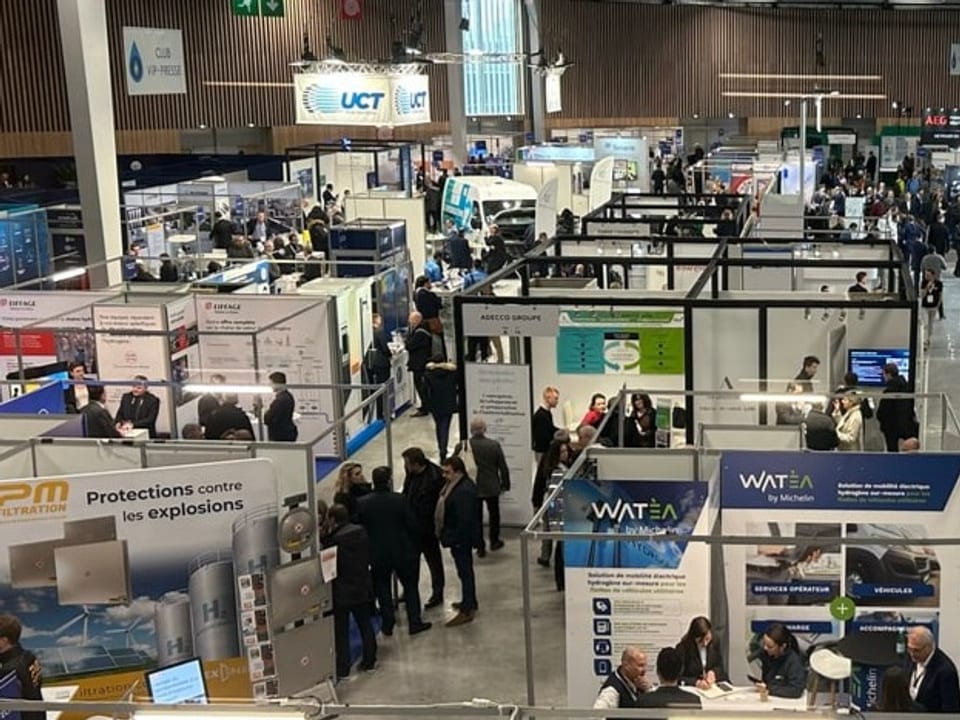Contents
Hydrogen should help industry with its immense energy consumption to become greener. There are a number of technical, financial and political stumbling blocks along the way.
The European hydrogen trade fair “Hyvolution” in Paris is an important indicator of the hydrogen industry. Stand after stand is lined up in a large hall on the exhibition grounds. Safety valves, storage solutions, drives for ships or cars, and even entire trucks are on display.
Jung Dong Woon is presenting its innovation at a stand. It’s not a big tank system, but an inconspicuous, beige tape. “When the ribbon comes into contact with hydrogen, it changes its color to blue or black,” explains Dong Woon. The smallest particles of palladium would react with the hydrogen and discolour. The invention of the South Korean adhesive tape manufacturer Daehyun should help to find leaks in pipes or pipe connections. Because hydrogen is a highly explosive gas. Accordingly, the beige ribbon is attracting great interest at the trade fair.
“Hydrogen is here to stay,” Carola Kantz is convinced. She represents the hydrogen industry in the German Machinery and Plant Construction Association and looked around the exhibition hall. The potential of hydrogen had been talked about for decades, and now it is on the verge of a market breakthrough. “We need it to decarbonize our energy and make us more independent.”
Investments worth billions
However, the hydrogen should not only be an alternative fuel for vehicles, but also supply the industry, which consumes enormous amounts of energy. Entrepreneur Jonathan Weber also wants to rely on green or climate-neutral hydrogen. He is part of the management of Stahl Holding Saar, one of the largest steel producers in Germany with 14,000 employees.
We don’t have a proper definition of green steel just like we don’t have a definition of green hydrogen.
From 2027 Weber wants to produce green steel. New furnaces that work with electricity and hydrogen are to replace the coal furnaces. In order to be able to carry the investments worth billions, he relies on support money from the EU. But he faces a problem: “We don’t yet have an actual definition of green steel, just like we don’t have one of green hydrogen.”
With the European Green Deal, the European Union has stipulated that Europe should be climate-neutral by 2050. But there are still no precise rules as to who is entitled to the subsidies and when, which are intended to support companies in the transition to renewable energies. But Weber can’t wait much longer. The new factories have to be built: “You just have to be more pragmatic here and understand that we can’t be 100 percent green in a transitional phase.”
“Politicians are too slow in working out new rules and issuing permits,” admits Rosalinde Van der Vlies. She is Director of Clean Planet in the EU Commission. But the change is very complex. It’s not just about technical innovations. The population must also participate in the change. This trust has to be created first.
Politicians are too slow in drafting new regulations and issuing permits.
Thierry Lepercq does not like to wait for political decisions. The energy entrepreneur relied on solar power early on. Now the Frenchman wants to offer large quantities of climate-neutral hydrogen for industry with the Hydeal consortium. “I first determined where the greatest demand is. And that is in industry,” he explains his business model: “I conclude long-term supply contracts with the customers. You secure cheap energy, so I get the money to invest in the systems.»
Green hydrogen from 2026
With his consortium, Lepercq wants to cover the entire value chain, from production in Portugal and Spain to pipelines and industrial groups as customers. From 2026 he wants to deliver the first green hydrogen. And that will trigger a chain reaction: “Thanks to the demand from industry, a new hydrogen infrastructure is being created and the supply of climate-neutral hydrogen is also growing. And in a second step, mobility will benefit from this: cars, trucks and ships.”
I conclude long-term supply contracts with customers. You secure cheap energy, so I get the money to invest in the systems.
Nevertheless, it should be a challenge to be able to produce enough green hydrogen in Europe itself to replace natural gas, coal and oil as energy sources. Thierry Lepercq wants to set up a global hydrogen network: “By 2030 we will need 20 million tons of hydrogen, and many more in the years that follow. 90 percent of European production will come from Spain and Portugal, 90 percent of global supply from Africa.”
With large-scale investments in Africa, he wants to secure gigantic amounts of cheap hydrogen thanks to the large supply of sun. At the same time, the African states should benefit from the water connections that are needed for hydrogen production and – according to Lepercq’s vision – from many new jobs. The entrepreneur is convinced that there are more sustainable ways of tapping into Africa’s energy wealth than those chosen by energy companies in recent decades.
Storing energy with hydrogen
Green hydrogen is an important link in making renewable energy from the sun or wind storable and balancing out supply fluctuations. The industry’s euphoria can be clearly felt at the hydrogen trade fair, but important questions have still not been clarified. It remains to be seen whether the necessary investments worth billions will also pay off and ultimately also depends on whether politicians create the framework conditions for building the appropriate infrastructure.
But it is also clear that, as with fossil fuels, the supply of hydrogen will hardly be the task of individual states, but will require international agreements and dependencies.

